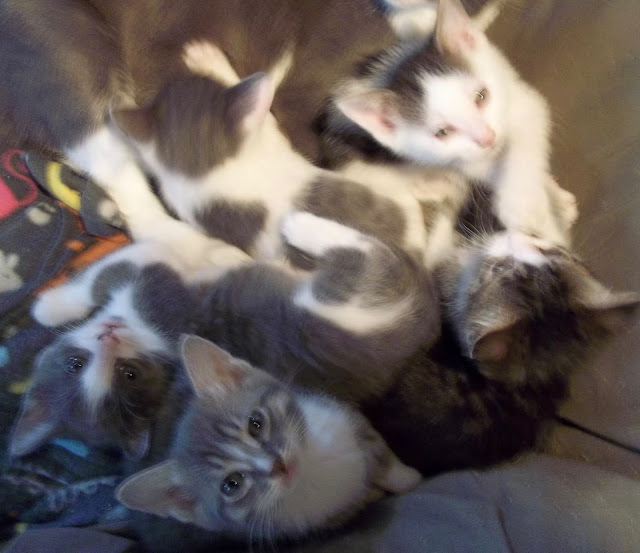People like to remark about people who won't consider new ideas or forget old ones that they have "a mind like a steel trap -- rusted shut." My mind is like flypaper: a lot of miscellaneous bits that move around but get stuck in no particular order. I'll just put some here in case they're useful. Ideally, they might develop into a system. Blogging is a way of taking a look and developing connections.
MAMMAL CHARACTERISTICS STAY WITH US
Family is the basic unit of life, but not all families include the male unless the situation demands more than one adult to preserve the children.
The nature of the individual and the culture come from pushing against the advantages and restrictions of the ecology: what to eat and how hard it is to get, how much shelter is needed, what sort of sensory world is offered for creating "metaphor".
Disease patterns shape populations. The evidence is that smallpox changed North America because it eliminated the human part of the ecology. Poverty is a disease. It is changing demographics which means changing the ecology, esp in cities.
Humans must fit into an ecology as much as a fish does. The primary evidence might be climate change due to atmosphere pollution. But small things like zebra molluscs can change the human ecology. Losing insects will reach a tipping point.
The Big Three US religious organizations are all family/tribal based. They come from areas with shrinking ability to sustain people, like the Mediterranean and the Levant, its east and south areas. Causes are ecological, affecting agriculture.
MEANS OF SOCIO-ECONOMIC SURVIVAL
Originally, human life was closely linked to place. Attachment pertains to both place and other humans (family). This applies to fishermen, herders, and farmers. Humans can make some changes: from fisherman to farmer, etc. but it will take time and cost both effort and disorder.
At one time mainly farming people were close to the ecology and therefore could control minimum existence. Now that so much money comes from occupations distant from the real ecology, specialized people end up on the sidewalk practically overnight. Their support is resented, their influence is nil.
The invention of money has meant that it has replaced reality. Bookkeeping of profit has taken priority over everything else, particularly the fantasy that a corporation is a "person" so it has a priority in law. Money is not real and neither is profit and neither is a corporation.
DEMOGRAPHICS, PARTICULARLY POPULATION DENSITY.
Villages and the cities are by definition creatures of population density. Thick populations mean moving commodities, which mean distribution and accounting, which means roads and transporting devices (trucks, railroads, airplanes) which means constant monitoring and maintenance.
BOUNDARIES TEND TO BE WHERE POPULATION IS THIN
But boundaries imposed by politics ignore those that develop organically. There are often tensions between the two origins. Boundaries, like cell walls, also create differences in value, thus commerce. But they can trigger war.
Two visibly different populations have three choices: ignoring or separating each other; assimilating; violence for the sake of dominance.
POPULATION DENSITY SUPPORTS INDUSTRIAL EDUCATION
Workers are a product of a country. To sustain a city or a military, education is necessary. If a city is wealthy enough, some of the education will not be directly useful but support usefulness. The shape and nature of the workers also determine the shape and nature of the country. Becoming too dependent on AI, thinking that gets away from labor, makes the entity vulnerable to energy changes, whether petro-based or green, because of infrastructure fragility and the inability of a single entity to control it.
"We" have had industrial mass education for centuries without changing much. Now we must, but how and what is the organizing principle, both goals and the obsession with steps and levels, certification, hierachy?
SEA LEVEL IS RISING
"Indonesia has just announced it's moving its capital because Jakarta is sinking into the sea. Jakarta is home to 10 million people."
Manhattan is said to have been built on granite which is why tall buildings are possible, encouraged by being on an island so that territory is limited. The City of Portland, Oregon, (which I know as the clerk for the Site Development Team as well as growing up there) is built in a river flood plain on sediment. Engineers will tell you that tall buildings are problematic. Valier, MT, is built on volcanic dust that expands and contracts according to the water. Houses there change shape through seasons and climate variation. Sea level will not directly impact Portland or Valier, which is a thousand miles inland. But climate will.
WE MUST REMEMBER SENSUAL PLEASURE
Not just the fantasy of ultimate sexual experience, but things like sunshine after bad weather, fresh-baked bread, well-loved music, and so on. This is what makes human life worth living. We can create it, remember it, plan it, tell each other about it, multiply, replicate it, share it.



